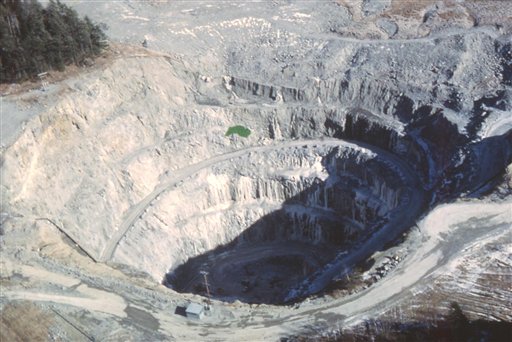AUGUSTA — Gov. Paul LePage has signed a new mining regulatory bill, but that doesn’t mean mining is new in Maine. In fact, it has a long history in the state going back to the early 1800s, when iron and lead extractions added to the state’s better-known granite and limestone quarrying industries.
While renewed interest in metallic mining of gold, silver, copper and other metals in Aroostook County’s Bald Mountain triggered the new legislation, state officials say it was time to bring Maine’s mining regulations up to date.
“In the 20 years since those rules were put in place, the state has adopted new storm water management, wastewater rules and quarry management regulations,” said state Geologist Robert Marvinney. “So the old mining rules were ready to be looked at again.”
The bill was signed into law last month. LePage does not set the scene for a sudden wave of swinging pickaxes and mechanical diggers. Rather, it puts into motion an overhaul of two-decades-old state mining regulations that will not be complete until 2014. And then, the rules must get the blessing of the Legislature.
Environmentalists are worried that the law will weaken current mining regulations.
Historically, one of Maine’s best-known metal mining operations was set off by the discovery of iron ore in 1848. It led to the Katahdin Iron Works operation in rural northern Maine, which continued into the 1890s.
Maine’s most recent metallic mining operations were conducted in the 1960s and ’70s. They included a zinc-copper open pit mine operated by Callahan Mining Corp. in Brooksville. Chemicals were used to extract the metals there, and the polluted Down East mine later became a federal Superfund cleanup site.
Kerramerican operated an underground mine for zinc and copper ores in Blue Hill, which operated until 1977.
That same year, Northeast Joint Venture discovered a massive metal deposit at Bald Mountain, which included a copper deposit estimated to be one of the most significant in North America, according to a history on mining on the state Geological Survey’s website.
Bald Mountain is situated on land that was purchased for timberlands by the New Brunswick-based J.D. Irving Ltd. in the late 1990s, said Anthony Hourihan, director of land development for the New Brunswick-based company. Since then, Irving has received inquiries from mining companies interested in Irving’s prospects for Bald Mountain.
Irving set out to find out if mining would be feasible, and was told it would not be if carried out under the state law dating back to 1991, Hourihan said.
The law “was very restrictive and not reflective of what was considered best practices in the rest of the world,” Hourihan said. For example, it did not take into account new technologies to treat groundwater affected by mining operations, he said.
While new regulations are being developed, Irving will continue looking into whether mining is worth pursuing. Even if it’s found to be feasible, there still would be years of engineering work and permit reviews, Hourihan said.
“It’s safe to say (mining) is five to seven years away even if it’s deemed feasible,” he said.
While metallic mining has remained dormant since the 1970s, Maine produces ample quantities of sand, gravel, slate and peat among other resources drawn from the ground. Among gemstones, Maine is well known for its tourmaline, the official state gem, and amethyst crystals have been pulled from a vein in the western Maine town of Sweden.
Exploration for metals has continued through the years in varying waves of interest. Companies have checked for deposits ranging from uranium and molybdenum to nickel and silver.
Environmental activists are leery of the new mining overhaul law, saying it weakens groundwater protection standards and cleanup requirements for mining operations.
Emily Figdor, director of Environment Maine, said the new mining law makes changes that could effectively be weaker than current regulations. For example, she said, it changes the definition of “mining area” so less of an area near operation would have to be restored.
“In directing the DEP to set rules, it weakens the framework for mining operations and paves the way for large open-pit mines,” Figdor said.
Currently, Maine’s mining regulations are shared by the Department of Environmental Protection and Land Use Regulation Commission. Those rules will remain in place until the new rules are developed by the DEP staff and then adopted by the Legislature, DEP Commissioner Patty Aho said at the bill signing. Aho promised “a thorough review of the best environmental regulatory approaches around the country to metal mining.”
Send questions/comments to the editors.




Success. Please wait for the page to reload. If the page does not reload within 5 seconds, please refresh the page.
Enter your email and password to access comments.
Hi, to comment on stories you must . This profile is in addition to your subscription and website login.
Already have a commenting profile? .
Invalid username/password.
Please check your email to confirm and complete your registration.
Only subscribers are eligible to post comments. Please subscribe or login first for digital access. Here’s why.
Use the form below to reset your password. When you've submitted your account email, we will send an email with a reset code.